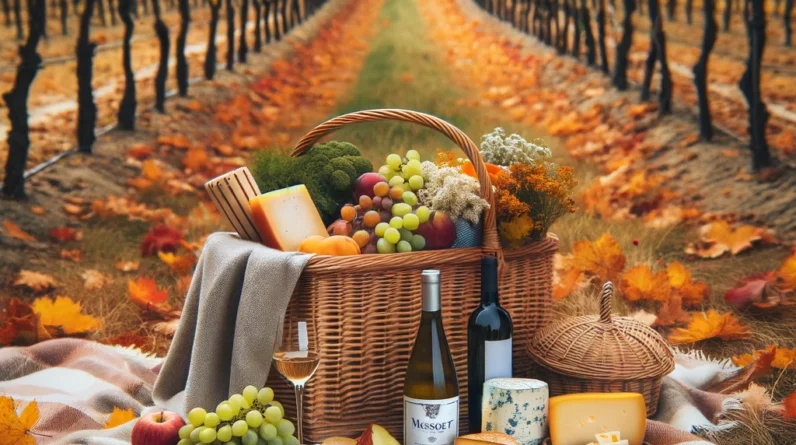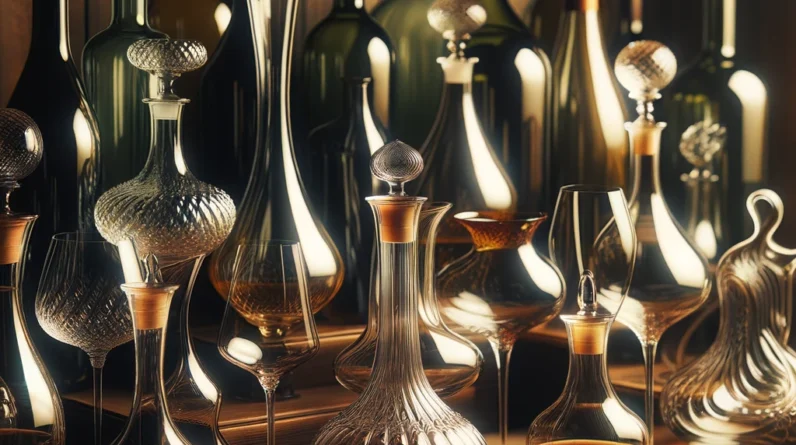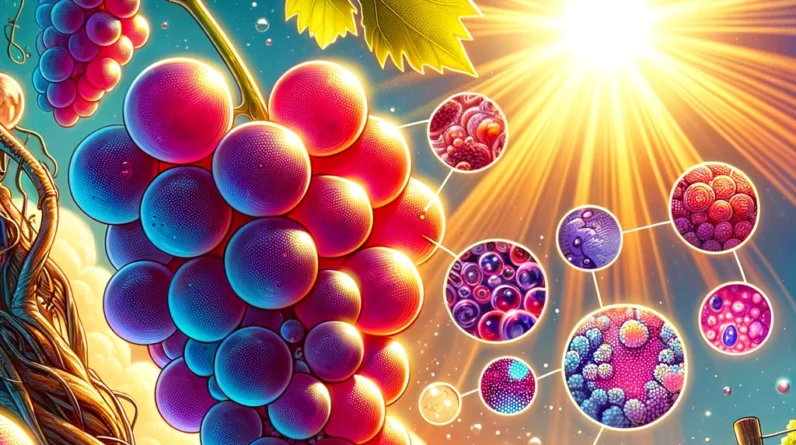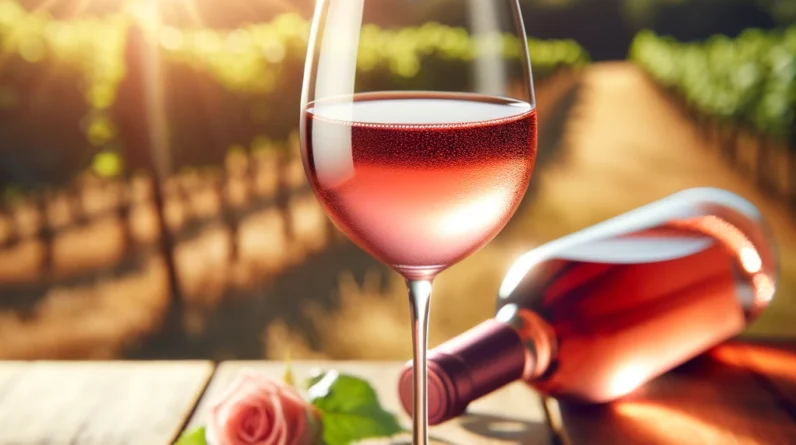
Tavel Rosé is a standout wine from the Tavel region in the Rhône Valley, France.
Known for its bold flavors and deep pink color, it differs from other rosé wines.
This wine has a rich history and a unique production process.
Whether you’re a wine enthusiast or a casual drinker, Tavel Rosé offers a distinctive and delightful experience.
In this article, we will explore what makes Tavel Rosé so special, including its characteristics, grape varieties, production process, and ideal food pairings.
Let’s dive into the world of Tavel Rosé and discover why it deserves a place in your wine collection.

History and Origin
Tavel Rosé comes from the Tavel region, a small area in the southern Rhône Valley.
This region is exclusively dedicated to producing rosé wine.
Wine has been produced here since Roman times, making it one of France’s oldest wine-producing areas.
Historical records show that the Romans cultivated vines in this area, appreciating the favorable conditions for growing high-quality grapes.
Over the centuries, the art of winemaking in Tavel has been refined and perfected.
The Tavel region is located in the southern part of the Rhône Valley, near the city of Avignon.
It is a small area, covering just over 900 hectares of vineyards.
Despite its size, Tavel is famous for its high-quality rosé wines.
The region’s unique terroir, with its stony soils and Mediterranean climate, contributes to the distinctive character of Tavel Rosé.
Tavel is the only appellation in the Rhône Valley that focuses solely on rosé wine.
This singular dedication ensures that Tavel Rosé is crafted with great care and expertise.
The winemakers in this region are committed to preserving traditional methods while also embracing modern techniques to enhance the wine’s quality.
Today, Tavel Rosé is celebrated for its bold flavors, deep pink color, and complex aroma.
It is a favorite among wine enthusiasts who appreciate its rich history and exceptional quality.
Whether enjoyed on its own or paired with food, Tavel Rosé offers a unique and delightful experience.

Characteristics
Tavel Rosé is distinct from other rosés due to its bold flavors and darker color.
Unlike the light, fruity rosés of Provence, Tavel Rosé has a deeper pink hue, almost red.
This striking color comes from the longer maceration process, where the grape skins stay in contact with the juice longer, giving it a richer color.
Tavel Rosé offers a richer taste profile with notes of red berries, spices, and sometimes a hint of earthiness.
You can often taste flavors like raspberry, strawberry, and cherry.
There are also subtle spicy notes like pepper and cinnamon, adding complexity to the wine.
Sometimes, you might even detect a slight hint of herbs or minerals, which adds to its unique character.
This wine is dry, meaning it has no sweetness.
It has a strong body, which means it feels fuller and more robust in your mouth compared to lighter rosés.
Tavel Rosé also has a higher alcohol content, often around 13-14%, which gives it a warm, satisfying finish.
The fuller body and higher alcohol content make Tavel Rosé more versatile with food pairings.
It can stand up to richer and spicier dishes that might overpower lighter rosés.
This makes it a great choice for meals, not just casual sipping.
WHAT GLASS TO CHOOSE FOR TAVEL?
Grapes Used
Tavel Rosé is made from a blend of several grape varieties.
The primary grapes include Grenache, Cinsault, and Mourvèdre.
These grapes are essential in creating Tavel Rosé’s unique character.
Grenache is the dominant grape in Tavel Rosé.
It adds rich flavors of red berries and a higher alcohol content.
Grenache also gives the wine its deep color and full body.
Cinsault is another important grape in the blend. It adds freshness and lightness to the wine.
Cinsault brings delicate floral notes and softens the robust flavors of Grenache.
Mourvèdre is also used in Tavel Rosé. This grape adds complexity and structure.
Mourvèdre contributes earthy and spicy notes, enhancing the wine’s overall depth.
In addition to these primary grapes, winemakers in Tavel often blend up to nine different grape varieties.
These can include Syrah, Carignan, Clairette, and Picpoul, among others.
Each grape variety adds its unique flavor and characteristic, contributing to the wine’s complexity.
This careful blending process is a key part of making Tavel Rosé.
Winemakers use their expertise to balance the flavors and achieve the desired taste and color.
The result is a wine that is rich, full-bodied, and aromatic.

Production Process
The production of Tavel Rosé involves two main methods: direct pressing and short maceration.
In direct pressing, the grapes are pressed gently.
The juice is immediately separated from the skins. This results in a lighter color wine.
Direct pressing is a common method for making rosé.
Short maceration is another method used for Tavel Rosé.
In this process, the grape skins stay in contact with the juice for a brief period.
This contact time can be from a few hours to a couple of days.
The longer the skins remain with the juice, the deeper the color of the wine.
Short maceration gives Tavel Rosé its signature deeper pink color.
It also enhances the flavor, making it richer and more complex.
The skins provide additional flavors, such as red berries and spices, which are typical of Tavel Rosé.
Both methods require careful control by the winemaker.
The choice of method and the duration of maceration can affect the final taste and appearance of the wine.
CHECK OUT THIS FANCY BOTTLE STOPPER!
Tasting Notes
Tavel Rosé is known for its distinct characteristics.
Color: Tavel Rosé has a deep pink color, almost red.
This vibrant hue sets it apart from other rosé wines, which are usually lighter in color.
Aroma: The aroma of Tavel Rosé is rich and inviting.
It has strong notes of red berries, like raspberries and strawberries.
You can also smell cherries and a touch of spice. This complex bouquet makes the wine very appealing.
Palate: On the palate, Tavel Rosé is dry, meaning it has no sweetness.
It is full-bodied, which means it feels rich and substantial in your mouth.
The flavors include raspberry and strawberry, giving it a fruity taste.
There is also a hint of spice, adding complexity to the flavor profile.
Tavel Rosé has well-balanced acidity. This means it has a refreshing sharpness that balances the fruit flavors.
The acidity makes the wine lively and enjoyable to drink.
The wine also has a long finish. This means the flavors linger in your mouth after you swallow, allowing you to enjoy the taste for longer.
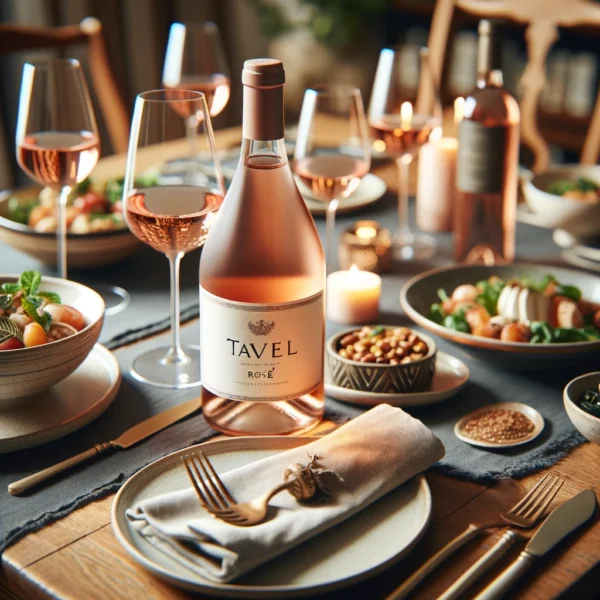
Food Pairings
Tavel Rosé pairs well with a variety of foods due to its robust flavor profile.
It complements Mediterranean cuisine.
Think of dishes like grilled fish, olives, and fresh salads.
The wine’s bold flavors match well with these fresh and vibrant foods.
Tavel Rosé is also great with grilled meats.
Whether it’s chicken, pork, or lamb, the wine enhances the smoky and savory flavors of the meat.
Spicy dishes are another good match.
The wine’s acidity and fruitiness balance the heat and spices in foods like curries or spicy sausages.
Heavier dishes, like stews and roasted vegetables, also pair nicely with Tavel Rosé.
The wine’s strong body and complex flavors can stand up to these rich and hearty meals.
This versatility makes Tavel Rosé a great choice for many occasions.
It is perfect for summer picnics, offering a refreshing complement to light, outdoor meals.
But it is also excellent for winter meals.
Its robust profile means it can accompany heartier, warming dishes enjoyed during colder months.

Serving Tips
Serve Tavel Rosé chilled, around 50-55°F (10-13°C).
This temperature is ideal for enhancing its refreshing qualities. When served at this temperature, the wine’s flavors really shine.
Using a standard wine glass is recommended. This type of glass allows you to fully appreciate the wine’s aromas.
The shape of the glass helps concentrate the scents, making the wine smell even more inviting.
Pour the wine into the glass and take a moment to enjoy its rich aroma.
Swirl the wine gently in the glass. This helps release more of its delightful scents.
As you take a sip, you’ll notice the wine’s complex flavors. Serving it at the right temperature ensures that you can taste all the nuances.
Tavel Rosé Wine Recommendations
1. Domaine de la Mordorée La Dame Rousse Tavel Rosé
Price Range: $20 – $30
Tasting Notes: This wine has a deep pink color with aromas of red berries, cherries, and a hint of spice.
On the palate, it is full-bodied and dry, with flavors of raspberry, strawberry, and subtle herbal notes.
It has a well-balanced acidity and a long, refreshing finish.
Grapes: Grenache, Cinsault, Syrah, Mourvèdre
2. Château d’Aqueria Tavel Rosé
Price Range: $20 – $25
Tasting Notes: Château d’Aqueria offers a Tavel Rosé with a vibrant pink color and aromas of strawberries, raspberries, and a touch of floral.
The palate is crisp and dry, featuring flavors of red berries, watermelon, and a hint of minerality.
The wine has a balanced acidity and a smooth finish.
Grapes: Grenache, Syrah, Cinsault, Clairette, Bourboulenc
3. Domaine Lafond Roc-Epine Tavel Rosé
Price Range: $15 – $25
Tasting Notes: This Tavel Rosé is known for its rich pink color and aromatic bouquet of red berries, cherries, and spices.
The palate is dry and full-bodied, with flavors of strawberry, raspberry, and a touch of citrus.
It has a lively acidity and a long, flavorful finish.
Grapes: Grenache, Cinsault, Syrah, Mourvèdre
4. Domaine de la Vieille Julienne Tavel Rosé
Price Range: $25 – $35
Tasting Notes: Domaine de la Vieille Julienne produces a Tavel Rosé with a striking deep pink color.
The nose is filled with aromas of ripe red fruits, spices, and a hint of floral.
On the palate, it is dry, full-bodied, and well-structured, with flavors of cherry, raspberry, and a touch of herbs.
The wine has a refreshing acidity and a lingering finish.
Grapes: Grenache, Cinsault, Syrah, Clairette
5. Prieuré de Montézargues Tavel Rosé
Price Range: $20 – $30
Tasting Notes: This Tavel Rosé features a beautiful pink hue and a nose of red berries, watermelon, and a hint of spice.
The palate is dry and medium to full-bodied, with flavors of raspberry, strawberry, and a touch of citrus. It has a balanced acidity and a clean, crisp finish.
Grapes: Grenache, Cinsault, Syrah, Clairette, Carignan, Mourvèdre
In summary, Tavel Rosé is a unique, high-quality wine that stands out for its bold flavors and rich history.
Whether you’re a wine enthusiast or a casual drinker, exploring Tavel Rosé can offer a delightful experience.
Its versatility in food pairings and its distinctive taste make it a worthwhile addition to any wine collection.
FAQs:
1. How long can you store Tavel Rosé?
Tavel Rosé can be stored for up to 2-3 years, but it is generally best enjoyed young to fully appreciate its fresh and vibrant flavors.
2. What is the ideal serving temperature for Tavel Rosé?
The ideal serving temperature for Tavel Rosé is between 50-55°F (10-13°C). Serving it too cold can mask its complex flavors.
3. Is Tavel Rosé suitable for aging?
While most rosé wines are meant to be consumed young, Tavel Rosé can benefit from short-term aging due to its robust structure and higher tannin levels.
4. How does Tavel Rosé differ from other rosé wines?
Tavel Rosé is known for its deeper color and richer, more complex flavors compared to the typically lighter and more delicate rosés from regions like Provence.
5. Can Tavel Rosé be used in cooking?
Yes, Tavel Rosé can be used in cooking. Its bold flavors make it a great addition to dishes like seafood stews, risottos, and sauces.
6. Are there any notable festivals or events in Tavel related to wine?
Yes, Tavel hosts several wine-related events, including the “Fête de la Vigne et du Vin” (Festival of Vine and Wine) in May, where visitors can enjoy tastings, vineyard tours, and local cuisine.
7. What are some top producers of Tavel Rosé?
Some top producers of Tavel Rosé include Domaine de la Mordorée, Château d’Aqueria, and Domaine Lafond Roc-Epine.
These wineries are known for their high-quality wines and consistent excellence.
8. What makes the terroir of Tavel unique?
The terroir of Tavel is unique due to its stony soils, which help retain heat and contribute to the ripening of the grapes.
The region’s Mediterranean climate, with hot summers and mild winters, also plays a significant role in the wine’s distinctive character.
9. Can Tavel Rosé be enjoyed year-round?
Yes, Tavel Rosé can be enjoyed year-round.
Its robust flavors make it suitable for both warm-weather sipping and pairing with hearty winter dishes.
10. What are some common misconceptions about Tavel Rosé?
A common misconception is that all rosé wines are light and sweet.
Tavel Rosé is neither; it is known for its full-bodied, dry profile and complex flavors, making it a serious wine for discerning palates.





